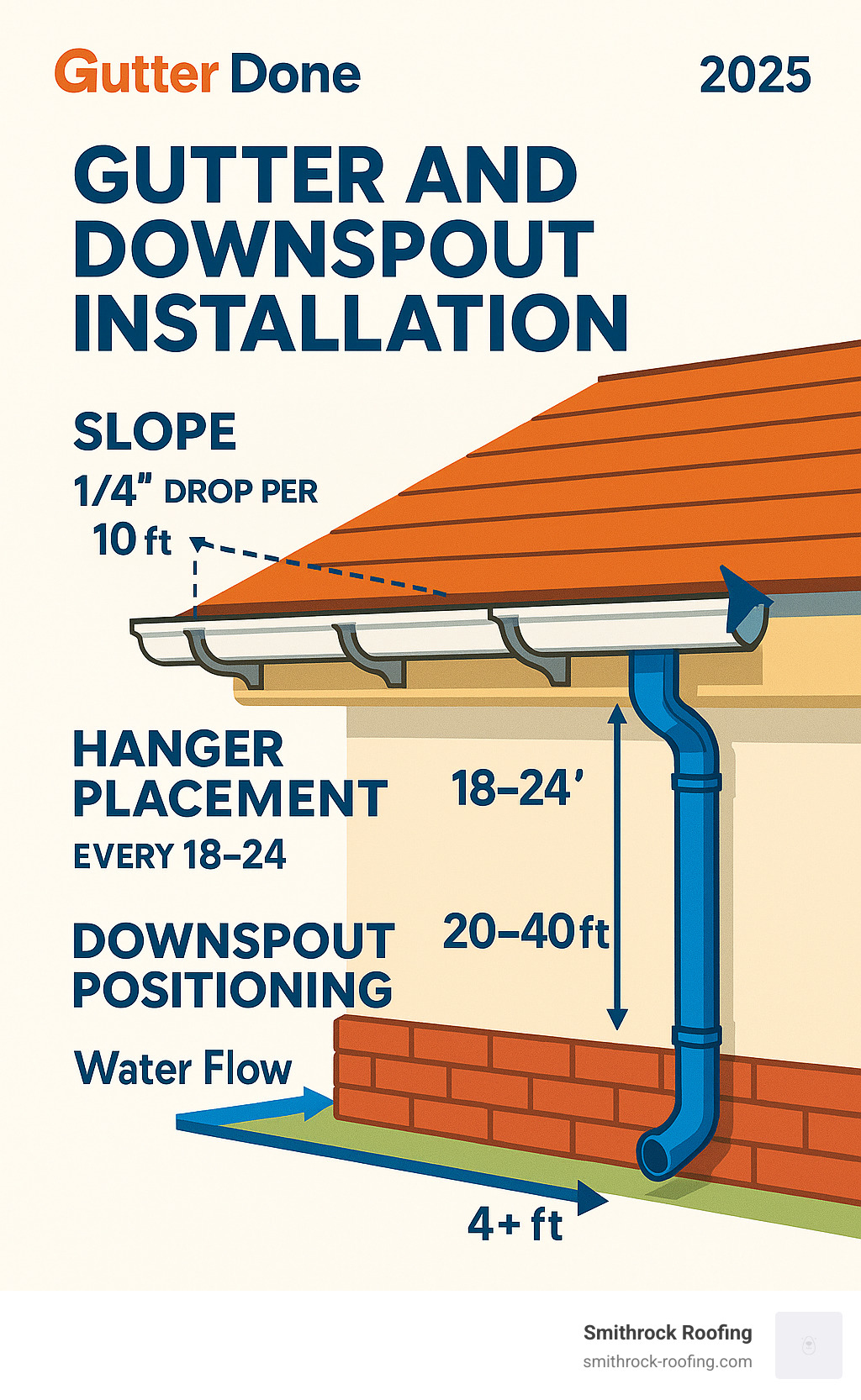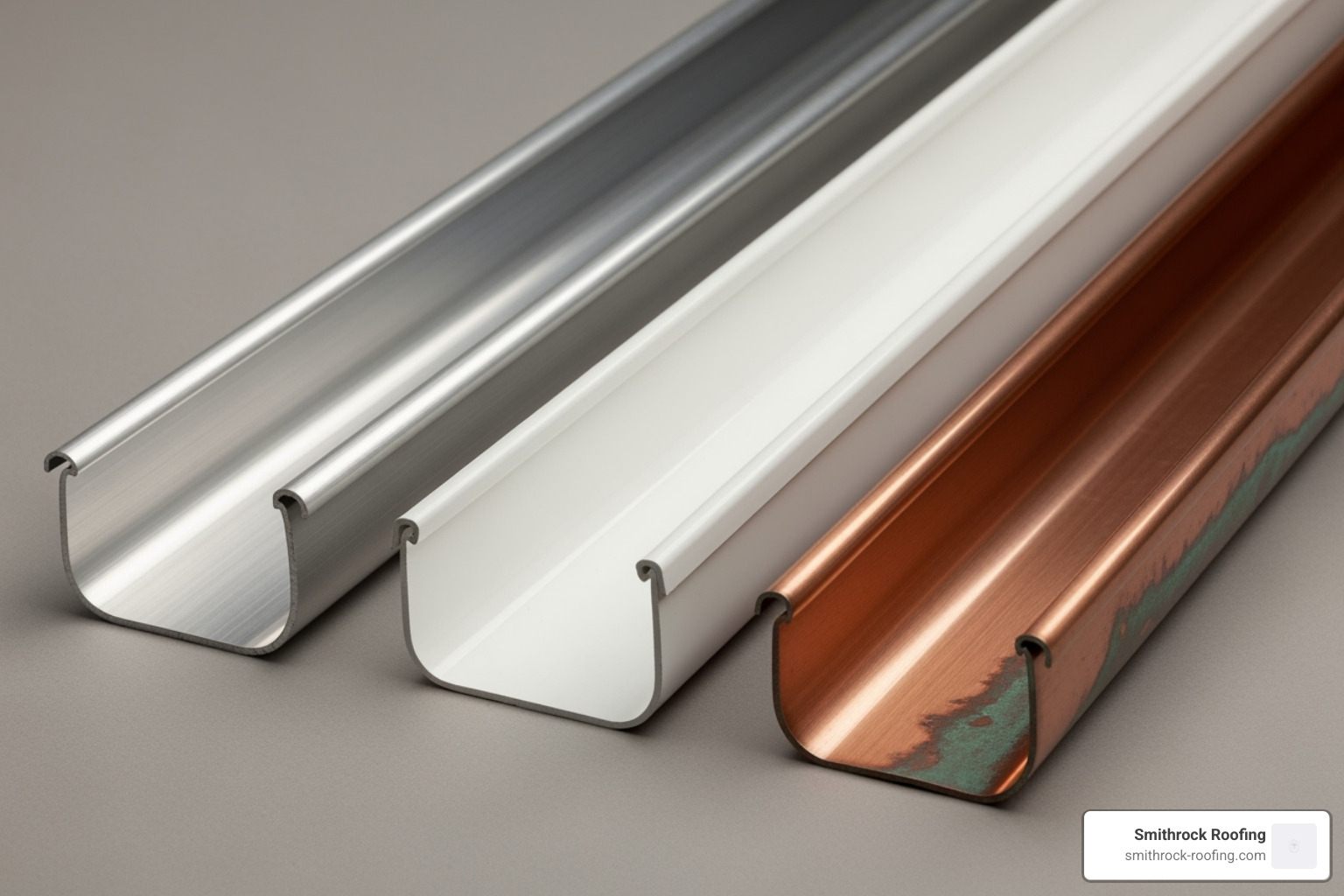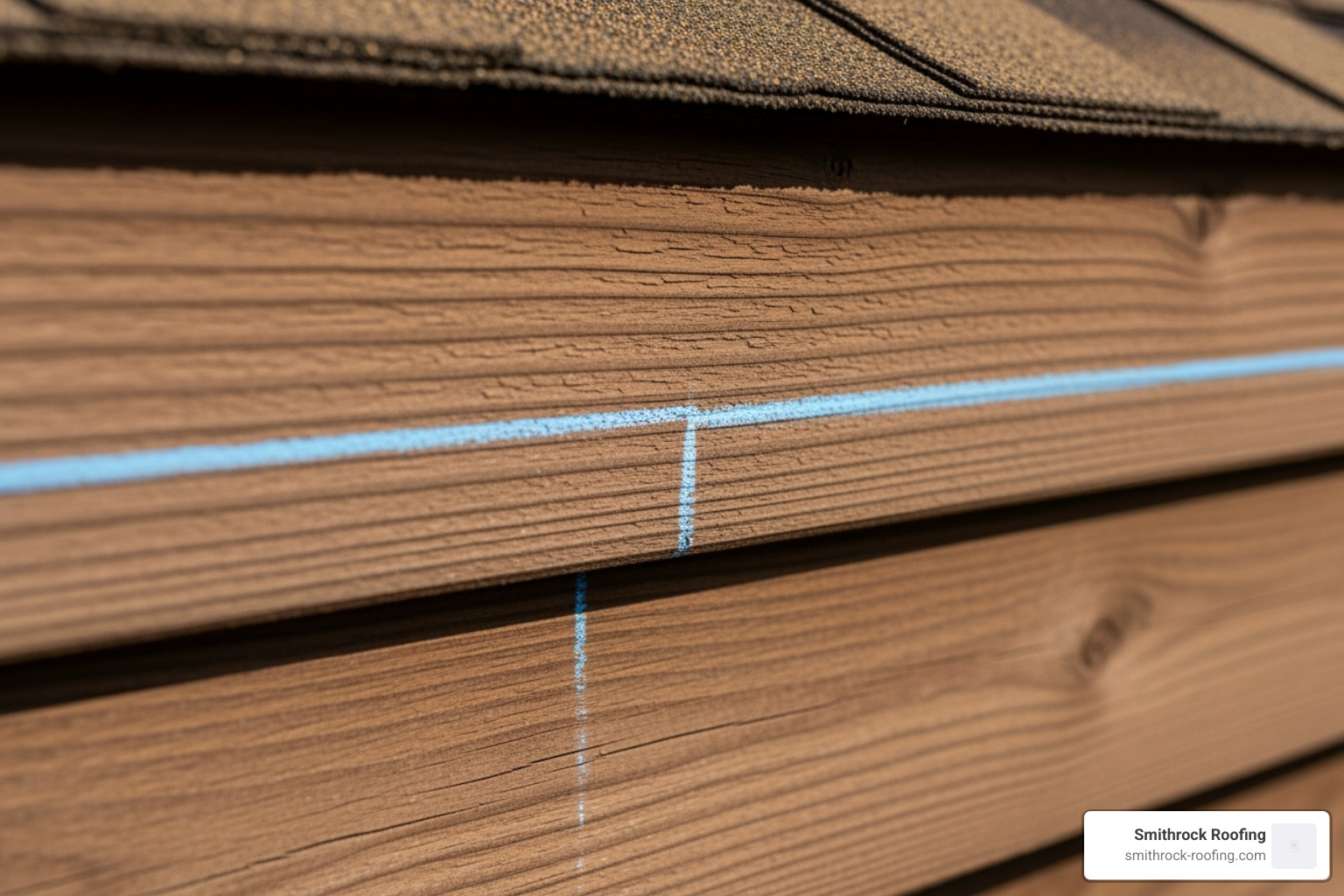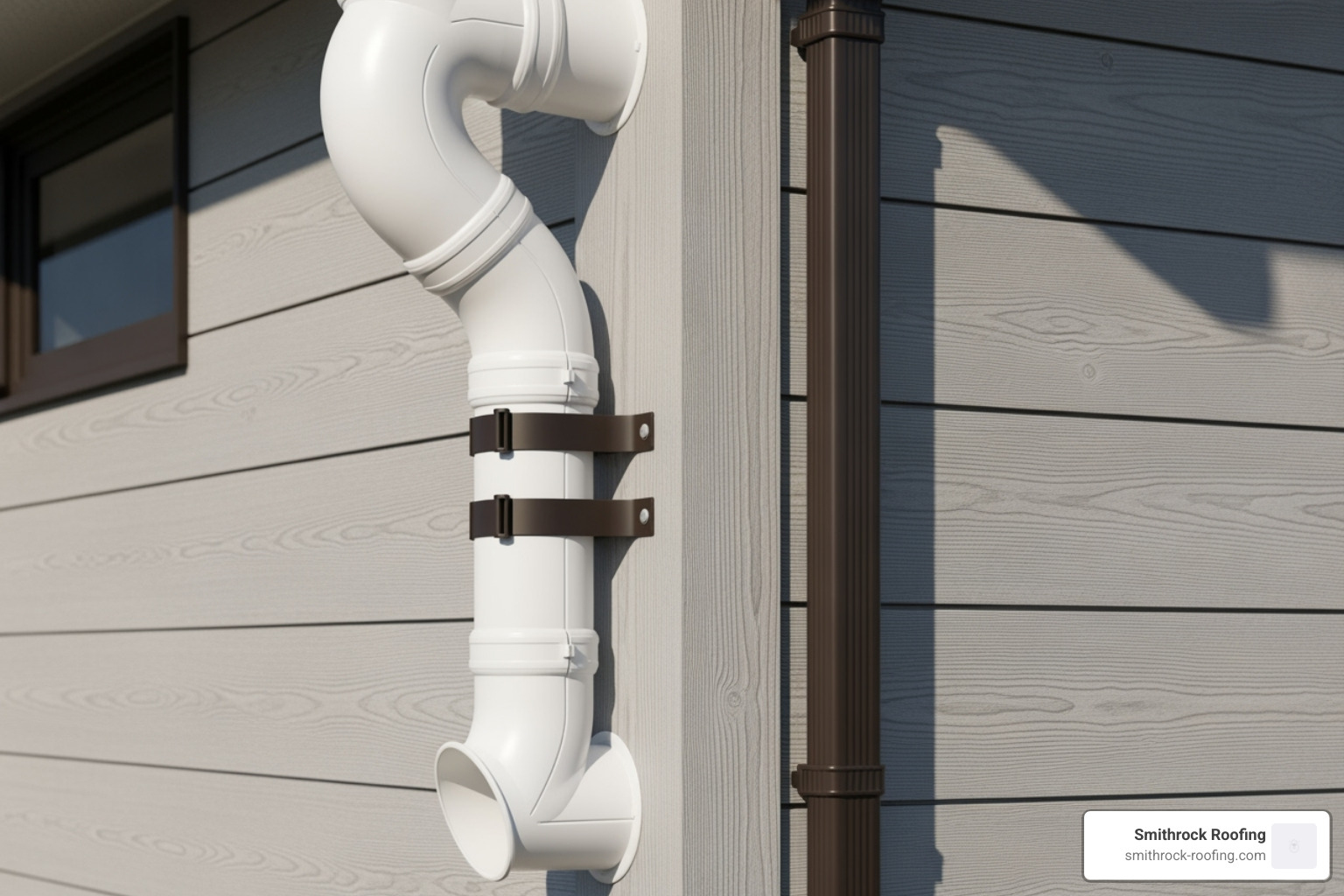Gutter and downspout installation: Flawless 2025
Why Proper Gutter and Downspout Installation Protects Your Home
Gutter and downspout installation is a critical home improvement project that protects your property from water damage. A correctly installed system directs rainwater away from your home’s foundation, preventing soil erosion, basement flooding, and structural issues that can lead to thousands in repairs.
Proper installation involves several key steps: planning the system based on roof area, gathering the right tools, marking a precise slope (1/4-inch drop per 10 feet), installing hangers securely into fascia, hanging the gutters, and placing downspouts every 20-40 feet with extensions. Research shows that improper installation, especially incorrect pitch, leads to common problems like sagging gutters, leaky seams, and foundation damage.
As someone with over 15 years in exterior construction, I’ve seen how poor gutter and downspout installation can cause expensive foundation and siding damage. My experience at Smithrock Roofing confirms that whether you choose a DIY or professional approach, understanding the process is key to ensuring your home stays protected for decades.

Gutter and downspout installation terms simplified:
Before You Begin: Planning Your Gutter System
Proper planning is the foundation of a successful gutter and downspout installation. Before you pick up a single tool, understand your home’s specific needs to create a system that effectively manages water.
Why Gutters are Your Home’s First Line of Defense
Without gutters, rainwater cascades off your roof directly to the ground around your foundation. This uncontrolled runoff can cause a host of expensive problems:
- Soil Erosion and Foundation Damage: Constant water bombardment washes away graded soil, leading to uneven settling and cracks in your foundation. Saturated soil can also freeze and expand, putting immense pressure on foundation walls.
- Basement Leaks: As water pools around your foundation, it seeps through cracks, leading to dampness, mold growth, and water damage.
- Damaged Landscaping: Uncontrolled water flow can destroy flowerbeds and shrubs.
- Siding Stains and Rot: Splashing dirt and constant moisture can stain siding, cause paint to fail, and lead to wood rot.
The importance of downspouts cannot be overstated. They are the critical component that carries collected water safely away from your home, making the entire gutter system functional.
Choosing Your Gutter System: Materials and Styles
Understanding the different gutter options will help you choose the right system for your home and budget.

- Styles: K-Style gutters are the modern standard, mimicking crown molding and handling more water than their classic counterparts. Half-round gutters are a traditional choice for historic homes, offering efficient flow and easier cleaning.
- Seamless vs. Sectional: Sectional gutters come in 10-foot lengths and are DIY-friendly, but every seam is a potential leak point. Seamless gutters, custom-made on-site by professionals, eliminate seams for superior performance and reduced maintenance.
- Materials: Your choice of material impacts cost, durability, and lifespan.
- Aluminum: The most popular choice. Lightweight, rust-resistant, and lasts 20+ years. Can be dented.
- Vinyl: The most budget-friendly option and great for DIY. Lightweight and won’t rust, but can become brittle in extreme temperatures.
- Steel: Very durable and handles heavy snow loads well. Heavier and more challenging to install than aluminum.
- Copper: The premium choice. Lasts 50+ years and develops a beautiful patina. Expensive and requires professional installation.
| Material | Cost (per linear foot) | Lifespan | Durability | Maintenance |
|---|
| Aluminum | $2-$6 | 20+ years | Good | Low |
| Vinyl | $1-$3 | 10-15 years | Fair | Low |
| Galvanized Steel | $4-$8 | 20-30 years | Very Good | Moderate |
| Copper | $20+ | 50+ years | Excellent | Very Low |
Sizing Gutters and Downspouts Correctly
Incorrect sizing is a common DIY mistake. Your system must be able to handle the water volume from your roof.
- Calculate Roof Square Footage: The larger and steeper your roof, the more water it collects.
- Consider Rainfall Intensity: Areas with heavy downpours need a more robust system.
- Gutter Width: Standard 5-inch gutters are suitable for most homes. For large or steep roofs, or in heavy rain areas, upgrade to 6-inch gutters.
- Downspout Sizing: Use 2×3-inch downspouts for 5-inch gutters and 3×4-inch downspouts for 6-inch gutters.
- Downspout Placement: Install one downspout for every 20-40 feet of gutter. For runs longer than 40 feet, pitch the gutter from the center toward downspouts at each end.
More info about our gutter services
Roof drainage systems International Residential Code (IRC)
DIY vs. Hiring a Professional
Deciding whether to do it yourself or hire a pro depends on your skill, time, and the complexity of your roof.
- DIY Installation: The main benefit is cost savings on labor. However, it comes with safety risks from working on ladders, is time-consuming, and potential mistakes (like improper pitch) can lead to costly water damage.
- Professional Installation: Professionals bring experience, ensuring correct sizing and pitch. They can install superior seamless gutters, understand local building codes, and offer warranties. If your home has a complex roofline, existing fascia rot, or you’re uncomfortable with heights, calling a pro is the smart choice.
Get a professional roof estimate
Gathering everything beforehand makes the project run smoothly.
- Essential Tools: Sturdy ladder, tape measure, chalk line, level, power drill, tin snips or hacksaw, gutter crimper, pop rivet gun, caulking gun, work gloves, and safety glasses.
- Essential Materials: Gutter sections (5 or 6-inch), downspouts (2×3 or 3×4-inch), inside/outside corners, end caps, gutter hangers, downspout elbows (A and B styles), downspout straps, 100% exterior silicone sealant, pop rivets or sheet metal screws, and gutter flashing.
The Complete Gutter and Downspout Installation Process
With your plan and materials ready, it’s time to begin the gutter and downspout installation. The key to success is to work methodically and prioritize safety at every step.
Safety First: Essential Precautions
Working at height is dangerous. Never compromise on safety.
- Ladder Safety: Use a sturdy ladder rated for your weight plus materials. Place it on firm, level ground.
- Work with a Partner: A helper can stabilize the ladder, pass tools, and call for help if needed.
- Three Points of Contact: Always keep two hands and one foot, or two feet and one hand, on the ladder.
- Avoid Power Lines: Aluminum gutters conduct electricity. Maintain a safe distance from overhead wires.
- Wear Protective Gear: Gloves protect from sharp metal edges, and safety glasses are non-negotiable.
- Don’t Overreach: Climb down and move the ladder instead of stretching unsafely.
Step 1: Pre-Installation Inspection and Prep
Installing new gutters over damaged fascia is a recipe for failure. Inspect the fascia boards (the boards along your roofline) for any signs of wood rot.
Probe any suspicious spots with a screwdriver; healthy wood is solid, while rotted wood will feel soft or crumble. You must repair or replace any damaged fascia boards before proceeding. This ensures you have a solid mounting surface that can support the weight of water-filled gutters. Prime and paint any new wood for protection.
gutters
Step 2: Mapping and Marking for Perfect Pitch
Proper slope is essential for drainage. The goal is a 1/4-inch drop for every 10 feet of gutter length toward the downspout.

- Establish the High Point: At the end of the run farthest from the downspout, mark a spot on the fascia 1 to 1 ½ inches below the roofline.
- Mark the Low Point: At the planned downspout location, measure down from the roofline by the same amount plus your calculated drop.
- Snap a Chalk Line: Stretch a chalk line between the high and low points and snap it. This line marks the bottom of your new gutter.
- Mark Hanger Locations: Mark spots for hangers every 18-24 inches along the chalk line, aiming for rafter tails for stronger support.
Step 3: Assembling the Gutters on the Ground
It’s much safer to assemble gutter sections on the ground than on a ladder.
- Measure and Cut: Measure your runs and cut sections to length with a hacksaw or tin snips.
- Join Sections: Overlap sections by about 8 inches, with the upstream piece inside the downstream piece. Apply a generous bead of exterior silicone sealant to the joint and secure with pop rivets on the sides of the gutter.
- Attach End Caps: Seal and rivet end caps onto the ends of your gutter runs.
- Cut Downspout Outlets: At the lowest point of your run, use a hole saw or snips to cut an opening for the downspout outlet. Attach the outlet piece from inside the gutter, sealing it thoroughly before securing with rivets.
Step 4: Hanging the Gutters
With a helper, it’s time to lift the assembled sections into place.
- Attach Hangers: Install your fascia brackets or hidden hangers along the chalk line, screwing them into the solid wood of the rafter tails whenever possible.
- Lift and Secure: Carefully lift the assembled gutter section and rest it in the hangers. Secure the gutter to the hangers according to the manufacturer’s instructions.
- Install Gutter Flashing: This crucial step prevents water from running behind the gutter. Slide a metal flashing strip under your roof shingles and over the back edge of the gutter. This directs all water into the system and protects your fascia from rot.
Step 5: A Guide to Downspout Installation
The downspout carries water safely away from your foundation.

- Attach Elbows: Attach a top elbow to the downspout outlet. Hold a bottom elbow against the wall to measure the length of the straight section needed to connect them.
- Cut and Crimp: Cut a straight downspout section to the required length. Use a crimper on the top end so it can slide into the top elbow.
- Assemble and Secure: Connect the elbows with the straight section. Secure the entire assembly to the wall with downspout straps placed every 3 feet.
- Direct Water Away: Attach a final elbow or extension at the bottom to direct water at least 4 feet away from your home’s foundation.
Learn more about proper installation
Avoiding Pitfalls and Ensuring Longevity
Even a well-planned gutter and downspout installation can fail if you’re not aware of common mistakes. Avoiding these pitfalls will ensure your system lasts for decades.
Top 5 Common Installation Mistakes to Avoid
- Improper Pitch: This is the most common failure. If the slope is too flat, water pools, adding weight and collecting debris. If it’s too steep, water can rush past the downspout outlet during heavy rain. Stick to the 1/4-inch drop per 10 feet rule.
- Incorrect Hanger Spacing: Spacing hangers more than 24 inches apart (or 16-18 inches in snowy climates) allows gutters to sag under the weight of water and ice, leading to pooling and potential collapse.
- Leaky Seams: In sectional systems, every joint is a potential leak. Failing to overlap sections correctly, using cheap sealant, or not securing joints with rivets will lead to drips that can rot your fascia board.
- Wrong Gutter Size: A system that’s too small for your roof’s size and pitch will be overwhelmed in a heavy storm, causing water to pour over the sides.
- Poor Downspout Placement: Too few downspouts or placing them where they dump water next to the foundation defeats the entire purpose of the system. Water must be directed at least 4 feet away.
Downspout Drainage Solutions and Alternatives
Effectively managing water at the end of the downspout is critical.
- Downspout Extensions: The simplest solution. Use plastic or metal extensions to carry water 4-8 feet away from the foundation.
- Splash Blocks: Concrete or plastic channels placed under the downspout outlet to disperse water and prevent ground erosion.
- Underground Drain Pipes: A more permanent solution where PVC pipes carry water from the downspout to a dry well or storm drain, keeping it completely away from the foundation.
- Rain Barrels: An eco-friendly option to collect and reuse rainwater for your garden. Ensure it has an overflow system to handle heavy rain.
- Rain Chains: A decorative alternative to downspouts that guides water down a chain. They are best suited for milder climates, as they can form large icicles in freezing weather.
The Impact of Climate on Your Gutter System
Your local weather should dictate your installation choices.
- Heavy Snow and Ice: In cold climates, use stronger hangers and space them closer together (every 16-18 inches) to support the immense weight of ice. Heat cables can be installed to prevent ice dams, which cause water to back up under shingles.
- Extreme Temperatures: Vinyl gutters can become brittle in extreme cold and warp in intense heat. Steel or copper are more durable choices for harsh climates.
- Heavy Rainfall: If your area experiences frequent, intense downpours, opt for larger 6-inch gutters and 3×4-inch downspouts to handle the higher volume of water without overflowing.
Post-Installation: Maintenance, Troubleshooting, and Costs
Your gutter and downspout installation is complete, but the work isn’t over. Regular maintenance is the key to ensuring your system protects your home for decades.
Your Gutter and Downspout Maintenance Checklist
Neglected gutters quickly become clogged, rendering them useless. A simple maintenance routine can prevent costly problems.

- Clean Twice a Year: Clean your gutters every spring and fall. If you have many trees, you may need to do it more often.
- Remove Debris: Use a gutter scoop and work gloves to remove leaves, twigs, and other debris.
- Flush the System: Use a garden hose to flush the gutters and downspouts. This clears out smaller debris and allows you to check for proper flow and leaks.
- Inspect While Cleaning: Look for loose hangers, sagging sections, or signs of leaks at the seams. Tighten fasteners and address small issues before they become big problems.
- Consider Gutter Guards: Guards (mesh, reverse curve, foam) can reduce the frequency of cleanings but do not eliminate maintenance entirely. They are a good option if you have many trees or find it difficult to work on a ladder.
Troubleshooting Common Gutter Problems
Even well-installed systems can develop issues. Here’s how to handle them:
- Leaky Seams or Holes: For small leaks, clean the area thoroughly, let it dry, and apply a generous bead of 100% exterior silicone sealant. For larger holes, use a gutter patch kit.
- Downspout Clogs: Try flushing the clog with a high-pressure hose nozzle from the top. If that fails, a plumber’s snake can often break it up. As a last resort, disassemble the downspout to remove the blockage.
- Sagging Gutters: This is often caused by loose or improperly spaced hangers. Add new hangers or tighten existing ones. If the fascia board behind the gutter is rotted, it must be replaced.
- Overflowing Gutters: The most common cause is a clog. If the gutters are clean, check the pitch with a level to ensure water is still flowing toward the downspout.
Understanding the Costs of Gutter and Downspout Installation
Costs vary based on materials, home size, and installation method.
- Material Costs (Per Linear Foot):
- Vinyl: $1 – $3
- Aluminum: $2 – $6
- Steel: $4 – $8
- Copper: $20+
- Professional Installation Costs: Prices often include materials and labor. Expect to pay more for multi-story homes, complex rooflines, or difficult accessibility.
- Other Cost Factors: The need for fascia repair will add to the total cost. Don’t skimp on the number of downspouts to save money; inadequate drainage will lead to overflow and potential water damage.
While DIY saves on labor, professional installation offers significant value. Pros provide warranties, have specialized equipment for seamless gutters, and possess the experience to avoid costly mistakes. This expertise often makes professional installation a better long-term investment.
Frequently Asked Questions about Gutter and Downspout Installation
Here are answers to the most common questions we receive about gutter and downspout installation.
How many downspouts do I need for my house?
The general rule is one downspout for every 20 to 40 feet of gutter. The exact number depends on two key factors:
- Roof Size: A larger roof collects more water and requires more downspouts to handle the volume.
- Local Rainfall: If you live in an area with frequent heavy downpours, you should place downspouts closer together (every 20-30 feet).
For any gutter run longer than 40 feet, it’s best to pitch the gutter from the center down toward a downspout at each end. This ensures water doesn’t have to travel too far, preventing overflow.
What is the correct slope for a rain gutter?
The correct slope is a 1/4-inch drop for every 10 feet of gutter run toward the downspout. This subtle pitch is critical for proper function.
This slope allows gravity to move water efficiently toward the downspout without letting it pool or rush so fast that it overshoots the outlet. While essential for drainage, this gentle slope is virtually invisible from the ground, so your gutters will appear perfectly level.
Can I install new gutters over a rotted fascia board?
No. Absolutely not. This is one of the most critical mistakes a homeowner can make.
Rotted fascia wood is soft and weak. It cannot support the weight of a gutter, especially when it’s full of water, leaves, or ice. Attaching a new gutter to rotted wood will inevitably lead to the gutter sagging and pulling away from the house, causing it to fail and potentially damage your home.
Always inspect your fascia boards before beginning your gutter installation. Any rotted sections must be cut out and replaced with new, solid wood. This is an essential step that ensures your new gutters have a secure foundation to last for decades.
Conclusion: Protecting Your Home’s Value
You now have a comprehensive understanding of gutter and downspout installation. Whether you’re planning a DIY project or hiring a professional, you’re equipped to make smart decisions to protect your home.
A properly installed gutter system is a modest investment that delivers huge returns. It works 24/7 to channel water away from your foundation, preventing basement floods, preserving your landscaping, and protecting your home’s structural integrity and curb appeal.
DIY installation can be a rewarding and cost-effective project. However, professional installation is the wiser choice for multi-story homes, buildings with complex rooflines, or if you want the superior performance of seamless gutters. A professional brings expertise, offers warranties, and provides the peace of mind that the job was done right the first time.
At Smithrock Roofing, we’ve seen how quality installation protects a home’s value. We understand that gutters are a key part of your home’s entire exterior defense system. Delaying replacement only gives water more time to cause expensive damage.
Your home deserves protection that lasts. Whether you tackle this project yourself or trust our experienced team, investing in a proper gutter and downspout installation is one of the most important moves you can make as a homeowner.
Contact us today to learn more about our gutter services





